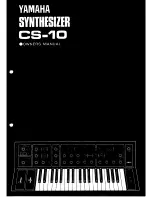
VIRUS Owner’s Manual
28
Operating Modes
In the Virus, we distinguished between two basic operating modes: SINGLE MODE and MULTI MODE.
This distinction of course has a bearing on the contents of the menus: If the LED of the SINGLE button is
illuminated, then the CTRL and EDIT menus provide access to the sound parameters of the current
SINGLE PROGRAM; if the LED of the MULTI button is illuminated, then the CTRL and EDIT menus
provide access to the organizational parameters of the current MULTI PROGRAM, for instance the
selection of SINGLE PROGRAMs for each of the 16 MULTI PARTs. Please keep in that MULTI PROGRAMs
only „administrate“ the SINGLE PROGRAMs contained therein, so you must store these SINGLE
PROGRAMs separately in the SINGLE banks.
MULTI SINGLE MODE
All involved SINGLE PROGRAMs can be edited within the MULTI PROGRAM. For this purpose, you must
activate the so-called MULTI SINGLE MODE by simultaneously pressing the MULTI and SINGLE buttons
so that both LEDs illuminate. Then you can switch among PARTs to process them via the PARAMETER
buttons; the menus CTRL and EDIT provide access to the SINGLE parameters of the selected PART. Here
the EDIT menu features additional organizational parameters, for instance PART VOLUME. The
PARAMETER buttons in the EDIT and CTRL menus are already used as the parameter activation tools, so
here you have to press and hold the MULTI button and use the VALUE buttons or the VALUE knob to
select a new PART.
MULTI SINGLE MODE enables direct access to the 16 PARTs, so it is the preferred operating
mode for use with a sequencer.
SINGLE MODE and MULTI MODE in turn are well-suited for activating and editing individual
sound programs (SINGLE) and combination sounds (MULTI).
The STORE Modes
The mode structure of SINGLE, MULTI and MULTI SINGLE MODE is mirrored in the STORE functions: In
SINGLE MODE, STORE saves the current SINGLE PROGRAM; in MULTI MODE, STORE saves the current
MULTI PROGRAM; and in MULTI SINGLE MODE, the SINGLE PROGRAM of the current PART is stored.
The STORE process is always the same regardless of the operating mode: Press STORE. You then gain
access to the STORE menu. There you can use the PARAMETER buttons to move among the individual
letters in the lower name entry line and the number of the destined memory location as well as the bank
number in the upper line. Use the VALUE button to make entries. The term in the upper display line
indicates the name of the memory location which you will overwrite when you store the program.
Once all of the entries correspond to the data you have in mind, press STORE again to conclude the
process and return to the previously active operating mode of the Virus. If for whatever reason you
change your mind and want to cancel the operation, simply press SINGLE or MULTI to return to the
previous operating mode without storing the program.
Controller Assignments
Virtually all of the parameters in the Virus are accessible via MIDI. For instance, you can record a knob
adjustment to a sequencer and have the Virus play it back later. MIDI Controllers are great for these
types of remote control operations because - in contrast to system exclusive data - they feature very fast
throughput (data transfer rate) and can be processed via graphical tools in the vast majority of popular
sequencer programs. Unfortunately you only have 128 Controller numbers at your disposal per MIDI
channel, so not all parameters of a Virus PART can be covered by Controllers.
Содержание VIRUS C SERIES
Страница 80: ...VIRUS Owner s Manual 80...









































